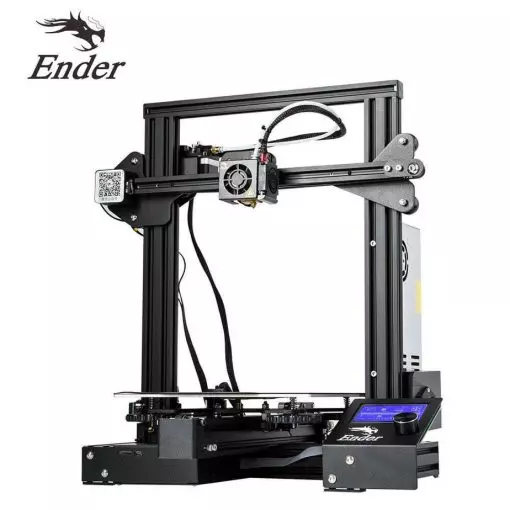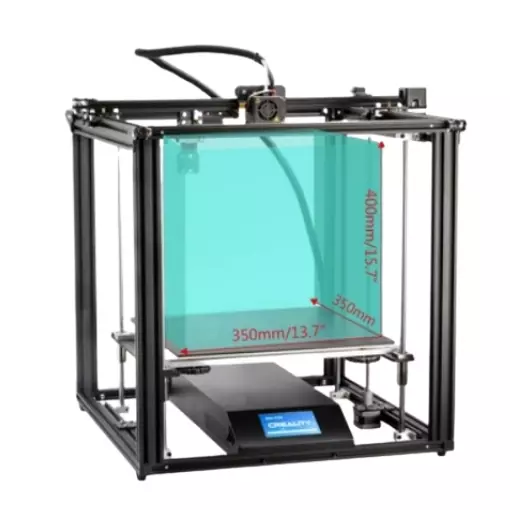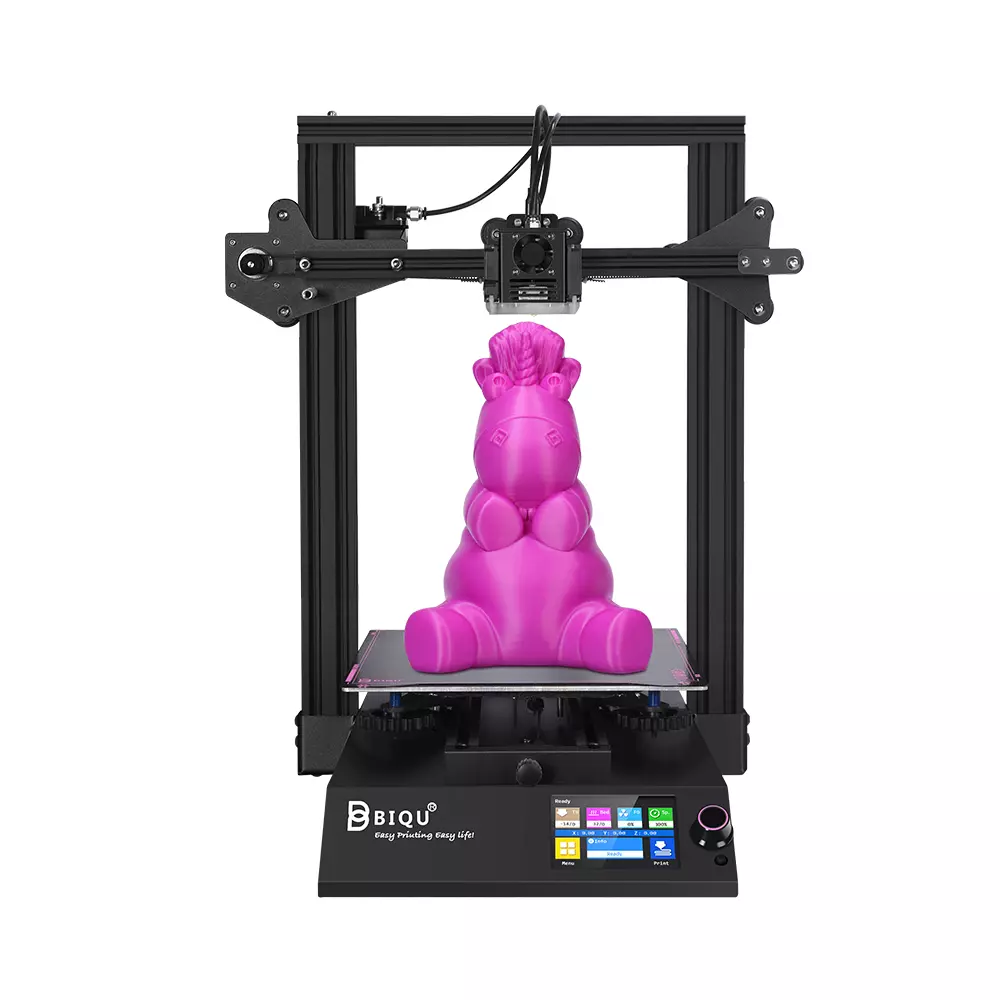Compare Ender 3 vs Ender 5 Plus vs BIQU B1
Comparison between the best 3D printers
Choose the best 3D printer at the best price. The cheapest 3D printers are here.
Buy a 3D printer here with 3D Fila.
 |
 |
 |
|
| Model | Ender 3[BUY Ender 3] |
Ender 5 Plus[BUY Ender 5 Plus] |
BIQU B1 |
| Printing Material | Filament | Filament | Filament |
| Estimated price | $210,00 | $599,00 | $269,00 |
| Fabricante | Creality 3D | Creality 3D | BigTreeTech |
| Release Year | 2018 | 2019 | 2020 |
| Print Volume [mm] | 220x220x250 | 350x350x400 | 235x235x270 |
| Printer Size [mm] | 440x440x465 | 632x619x666 | 412x402x492 |
| Weight [kg] | 6,62 | 18,2 | 8,00 |
| Power Loss Recovery | NO | YES | YES |
| Enclosed printer | NO | NO | NO |
| Bed Leveling | Manual | Automatic | Manual |
| Filament End Sensor | NO | YES | YES |
| Bed type | Heated | Heated | Heated |
| Power supply system | Bowden | Bowden | Bowden |
| Standard nozzle | 0,4 | 0,4 | 0,4 |
| Maximum Nozzle Temperature [°C] | 255 | 260 | 250 |
| Maximum Bed Temperature [°C] | 110 | 100 | 100 |
| Maximum printing speed [mm/s] | 180 | 180 | 100 |
| Filament holder | YES | YES | YES |
| Camera for supervision | NO | NO | NO |
| Recommended filaments | PLA, TPU, ABS, PETG | PLA, TPU, ABS, PETG | PLA, TPU, ABS, PETG |
| Recommended slicers | Cura, Simplify, Slic3r | Cura, Simplify, Slic3r | Cura, Simplify, Slic3r |
| Maximum Resolution [mm] | 0,1 | 0,1 | 0,1 |
| Processor | 8 bits | 32 bits | 32 Bits BTT SKR V 1.4 |
| Display | Mono | Touchscreen TFT 4,3'' | Touchscreen TFT 3,5'' |
| Power Supply | 24V / 270W | 24V / 504W | 24V / 360W |
| Connectivity | SD / USB | SD / USB | SD / USB |
| Operating systems | Windows, Mac, Linux | Windows, Mac, Linux | Windows, Mac, Linux |
| Date of registration in the system | 2021-04-13 | 2021-04-14 | 2021-04-14 |
| Release date | 2018 | 2019 | 2020 |
| Extra features | The Ender 3 V1 is a DIY assembly 3D printer, a sales leader since 2017, standing out for its cost-benefit. With a wide printing capacity, it has a CNC machined structure for precision and stability. It offers high-precision prints with low noise, thanks to its innovative V-profile and pulleys. It has a self-adhesive magnetic platform for easy removal of models and excellent adhesion. The Ender 3 heats up quickly, reaching 100°C in 5 minutes, ideal for agile prints. It includes protection against power failures, allowing you to resume printing after interruptions, saving time and material. | The Ender 5 Plus offers a large print volume (350x350x400 mm) and fast assembly. It includes a BLTouch sensor, but with range limitations. It stands out for its dimensional accuracy, although it requires adjustments to the slicer settings. Despite the noise, its integrated design saves space, and includes features such as a filament sensor and power resumption. Ideal for large projects, it requires refinement in the settings for high-quality prints. | The BIQU B1 is an advanced 3D printer with a silent 32-bit BTT SKR V1.4 motherboard and ARM Cortex-M3 CPU, offering DIY interfaces (I2C, SPI, WiFi) and dual Z-axis. Its dual BTT B1 TFT35 V3.0 operating system allows real-time monitoring and multiple printing modes, including G-code visualization effects. It stands out for its BIQU SSS (Super Spring Steel), ensuring easy model adhesion and simplified removal, with the possibility of using it on both sides. It includes a filament sensor, automatically pausing printing in case of filament breakage. The multicolored RGB lights integrated into the hotend allow you to view the printing status even at night. Additional notes include the need for a BIQU-specific Type-C cable and extra interfaces for smart filament sensor and BL Touch. |
| Support for multiple colors and materials (AMS and CFS) | NO | NO | NO |
Notes * |
|||
| Cost-benefit | 6 / 10 | 6 / 10 | 7 / 10 |
| Hardware | 0.5 / 10 | 2 / 10 | 2 / 10 |
| Screen | . | . | . |
| Print volume | 3 / 10 | 4 / 10 | 3 / 10 |
| Performance | 1 / 10 | 1 / 10 | 1 / 10 |
| [BUY Ender 3] | [BUY Ender 5 Plus] |
Conclusion |
| In comparing the Ender 3, Ender 5 Plus, and BIQU B1 3D printers, several critical aspects come into play, influencing both functionality and value. The **Ender 3** stands out for its cost-effectiveness and simplicity. It offers a solid print volume for entry-level users and is known for its reliability and ease of assembly. Despite its manual bed leveling process and lack of advanced features such as power loss recovery, its low price attracts many hobbyists and beginners. The **Ender 5 Plus**, while more expensive, justifies its higher price point with a larger print volume and automatic bed leveling. This model is tailored for users who need to handle more substantial projects requiring precision and efficiency. However, it does require some adjustments to slicer settings for optimal results and may produce more noise during operation. On the other hand, the **BIQU B1** offers advanced features such as a silent 32-bit motherboard and a Dual Z-axis system, accompanied by a competitive price. It excels in user experience with its dual TFT interface and smart filament sensor. However, its lower maximum printing speed and the need for specific cables may deter less tech-savvy users. Overall, if budget is the primary concern, the **Ender 3** provides excellent value for novices. For those looking for larger build sizes and more automation, the **Ender 5 Plus** delivers quality and reliability, albeit at a higher cost. The **BIQU B1** strikes a balance between features and price, appealing to moderately experienced users seeking a mix of advanced technology without breaking the bank. Ultimately, the choice depends on the user's specific needs, experience level, and willingness to invest in additional features. |

